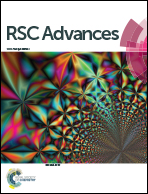Enhancements inside and outside the junctions of Ag colloidal dimers†
Abstract
We measured experimentally the enhancements inside and outside the junctions of Ag colloidal dimers. We prepared two kinds of substrates for surface-enhanced Raman scattering (SERS) by using three- and four-step immobilization methods. The three-step method consists of the following procedures: immobilization of Ag colloidal particles, adsorption of target molecules on the immobilized colloidal particles, and a second immobilization. For the four-step method, aniline is adsorbed in the second step, while target molecules are adsorbed in the fourth step. We optimized the diameter of Ag colloidal particles to achieve a high Raman enhancement from their dimers. When Ag sols, purified by centrifugation, were used in the immobilizations, dimers were predominantly formed with very few trimers formed. The substrate fabricated by the three-step method showed 6.5 times higher SERS intensity than the substrate fabricated by the four-step method. In both methods, the dimers were formed during the second immobilization. Therefore, the intensity difference was due to the fact that some target molecules were present at the junctions for the former substrate, while none at the junctions for the latter substrate. The enhancement on the dimers was about 1.03 × 108 for the substrate prepared by the three-step method, while 1.48 × 107 for the substrate prepared by the four-step method. The value of 1.48 × 107 corresponded to the enhancement outside the junctions, since no target molecules could be present at the junctions of the dimers for the substrate prepared by the four-step method. From the intensity difference between the two kinds of dimers, the percentage of the enhancement contributed by the target molecules presenting inside the junctions of the dimers where benzenethiol could not be adsorbed by diffusion was calculated to be about 86%. We estimated the surface area inside the junctions where the sum of the SERS signals was corresponding to 86% of the total SERS signals by a finite difference time domain (FDTD) calculation. It was in the range of 0.5–0.7% of the total surface area. Based on this data, we could calculate roughly the enhancement inside the junctions. The enhancements inside and outside the junctions of the dimers were the order of 1010 and 107, respectively.



 Please wait while we load your content...
Please wait while we load your content...